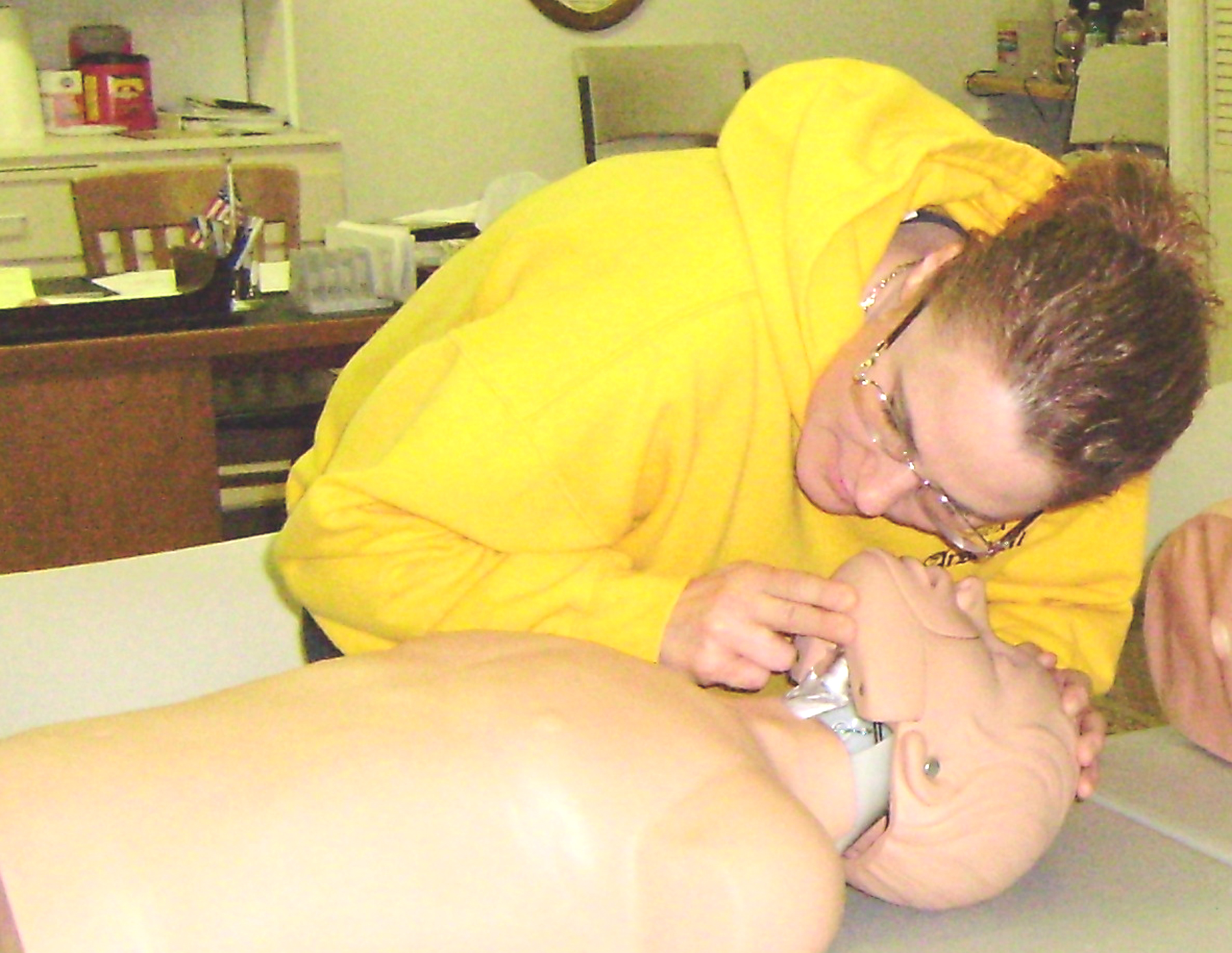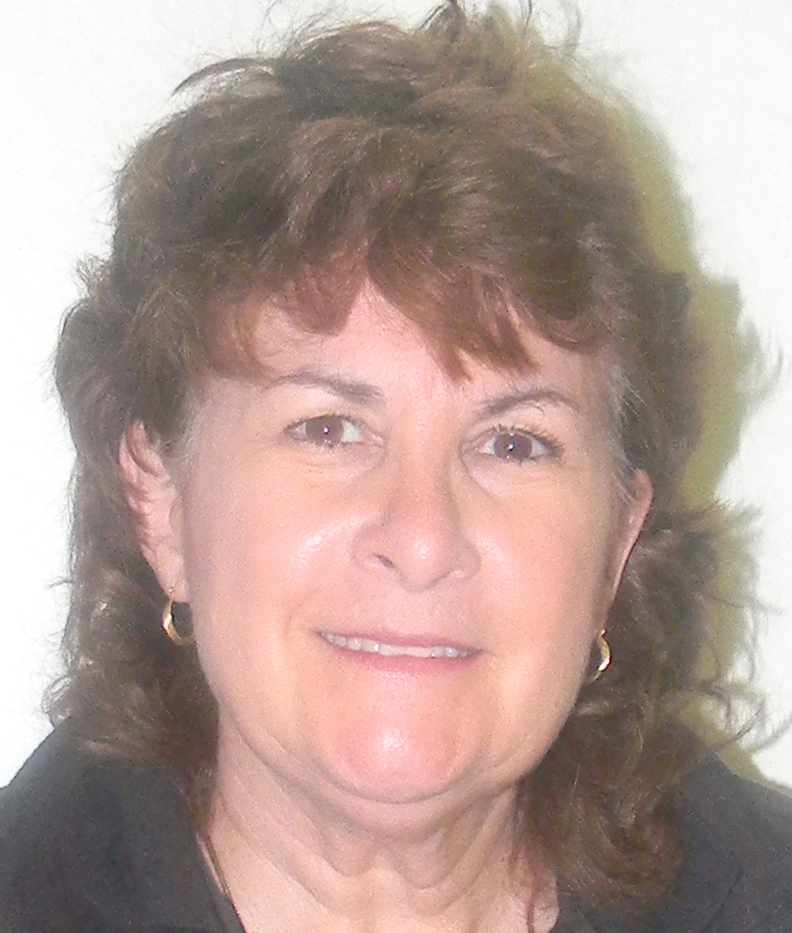
A STUDENT learns CPR in a class taught by Christine Cooley, an EMT and the curator of the Benicia Fire Museum.
Courtesy photo
By Donna Beth Weilenman
Staff Reporter
If someone hasn’t taken a cardiopulmonary resuscitation (CPR) or first aid class in a few years, the way they’re currently taught might come as a surprise, Christine Cooley said.
Cooley is known for her longtime affiliation with the Benicia Fire Department. She is the assistant curator of the Benicia Fire Museum.
She’s also a moulage artist who has applied makeup for the mock injuries at the Benicia High School and Benicia Police Department “Every 15 Minutes” events.
And Cooley is an emergency medical technician who frequently is on duty at city and community events.
In her own business, she teaches both CPR and first aid to community groups, city employees and business employees, as well as to members of the Benicia Emergency Response Team. As a volunteer firefighter, she’s been a member of BERT since its founding.
“I encourage people to be certified,” she said.
But if they haven’t taken a rescue course before — or haven’t taken one in a long time — people may be surprised to learn how much more emphasis is on compressions rather than mouth-to-mouth breathing, Cooley said.
In fact, while it doesn’t qualify for certification, “you can learn compression online,” she said. “It’s the most important part.”
That’s the opinion of the American Heart Association, which offers a 60-second video on its Web page, www.heart.org, under the heading “CPR & ECC.”
“(Compression) keeps the blood pumping,” Cooley said.
That emphasis differs from the days in which mouth-to-mouth resuscitation was being promoted as key to reviving a non-responsive person.
Mouth-to-mouth resuscitation was recognized as far back as 1740, though James Elam was the first to prove that the method was sufficient to maintain adequate oxygenation, in 1954. He and Peter Safar are credited as having invented the modern mouth-to-mouth resuscitation technique in 1956, and their method was adopted by the United States military the next year.
The American Heart Association (AHA) began teaching the forerunner of CPR to physicians in 1960s. Leonard Cobb began popularizing the teaching of the rescue system to citizens in 1972; within two years he’d helped train more than 100,000 people.
But the system constantly is being examined, modified and upgraded, Cooley said, and “what we’re finding is people don’t want to do mouth to mouth. She said AHA studies have indicated that compressions could be sufficient, so long as professional first responders arrive in six minutes or less.
In Benicia, she said, that’s likely.
However, there is equipment people can carry so they don’t have to make direct mouth-to-mouth contact, Cooley said.
“I carry one on a keychain in my bag,” she said. The device “is very simple. It’s a one-way valve. It prevents transmission of disease.” And it’s not expensive — about $4 to $8, she said.
Her students learn about these devices and others, as well as multiple techniques in her classes. Some techniques can last hours, not just 60 seconds.
Cooley teaches classes to nine or fewer people, because nine is the maximum student-to-teacher ratio recommended by the AHA.
She also teaches classes in her home.
The classes cost between $40 and $60, depending on how many enroll. Each person gets a manual, a two-year certification card and between four and seven hours of instruction.
Those taking one of two levels of CPR will get instruction that lasts about four hours. Those combining CPR with first aid can expect about seven hours of training.
“I teach CPR and basic first aid,” she said.
She’s been dong that off and on since the 1970s, when as a life guard she was inspired to learn more about rescue training.
For the past five years, she’s done it as part of her business, CnT.
“I have classes almost all the time,” she said.
“I don’t sit you in front of a video and take your money. I train you!”
As changes are made to CPR and first aid rescues, “we see saves in the field going up,” Cooley said.
However, some are still reluctant to learn. That can be costly to those who need emergency help, she said.
“For each minute compressions are not done, survival chances drop 10 percent,” she said.
“Here, the response time is two to six minutes,” she continued. If a responder doesn’t arrive for six minutes, and no one provides CPR, a victim’s survival chances will drop 60 percent, she said.
Another lifesaving tool that is spreading in popularity is the automated external defibrillator (AED), which checks a heart’s rhythm and if necessary, can send a shock that can help the heart re-establish its rhythm.
Cooley’s students learn about those devices, too, she said. In Benicia, they’re going in most of the city’s buildings: A donation by Valero Benicia Refinery put the newest AED in the Clock Tower building in the Arsenal.
They’re also being placed in schools.
“They’re everywhere,” she said, especially since their prices have dropped from several thousands of dollars to about $1,200.
No training is required to use an AED. The machine literally talks a person through its operation, and it applies shocks only if it detects a life-threatening cardiac arrhythmia.
In Cooley’s classes, students discover other changes in the way people are trained, including the elimination of some practices.
For instance, people no longer are trained to elevate the legs of those in shock and unresponsive. That’s to prevent further injury if a leg has been damaged, Cooley said.
At one time, anyone feeling faint was told to sit down and put their head down between the legs. However, some people fainted anyway, fell forward and suffered head injuries. Now people are trained to have someone feeling faint lie down flat.
For a while, tourniquets were unpopular, feared as causing additional damage and causing victims to lose limbs. “They’ve returned,” Cooley said. “Too many people were bleeding out.”
Her students also are taught to use inhalers; when to give and to avoid aspirin to those having heart attacks; and how to use epinephrine pens or injectors to treat anaphylaxis.
Those who want take one of Cooley’s classes or have her teach at an organization or business may call her at 707-747-9479 or email her at cac6827@sbcglobal.net.
While she encourages Benicia residents to become certified in CPR and first aid, she favors anyone take at least one step, if nothing else.
“Watching the ‘Hands Only’ video, you can save a life,” she said.







Leave a Reply